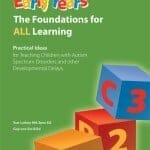
When working with any child with ASD it is critically important that the programme implemented is realistic, both for the child and for the family. By realistic I mean setting everyone up for (achievable) success and that everyone across all environments has the time to implement it. I believe the best way to create a realistic programme is to only address one or two ideas at any one time.
I recommend in the early years you always have the goals you are working on in a prominent place (e.g. fridge or preschool office) so ALL people engaging with the child know the week’s two goals. Over the years I have found by displaying the goals ensures consistency and everyone creating opportunities to reinforce the goal.
As children with autism spectrum disorders are highly individual not all strategies may work with every child. If you find this to be the case, remember that it is worth revisiting an old strategy in the future as it may work then. Most children respond best to a range of strategies.
Below I have chosen two very important skills, ‘Pointing’ and ‘Asking for Help,’ to teach children as examples of two goals you could work on at the same time.
Pointing: Appropriately Using Gesture to Communicate
Why Do We Teach this Skill?
- Pointing is an important non-verbal means of communication.
- Pointing is a skill that neuro-typical children learn spontaneously. Children with ASD need to be formally taught this skill, as instead of pointing they ‘drag’ or ‘lead’ adults to what they want. Even very young children with ASD can be very strong and as they grow older and stronger the adult may be injured if dragging behaviour is allowed to persist.
How to Promote this Skill:
- Model appropriate pointing whenever possible as you communicate with your child e.g. when giving your child a drink, point to the drink and say “Drink” before you give it to him.
- In order for pointing to be an effective form of communication the child needs to be taught to look at the other person.
- Wait. Remember to give your child time to process and then point.
- When your child is ready to make a choice rather than letting him grab the preferred item, anticipate his action and mould his hand gently into a point.
- Ensure that all key adults use pointing with the child – consistency is vital in the acquisition of this skill.
- Some children need many fine motor experiences to help them develop independent pointing. In addition to helping your child learn how to point (gently put your hand over his and form his index finger into a point), you may need to give your child many experiences with actions to songs and finger plays as well as a range of other fine motor activities.
Pointing is a vital skill and consistency is the key.
Help: Learning to Ask for Assistance from Other People
Why Do We Teach this Skill?
- Once the child is able to ask for assistance when he needs it, his frustration and the frequently resulting tantrums will decrease.
How to Promote this Skill:
- Every time the child takes your hand to pull you somewhere, pause and clearly say “Help”.
- Once he is used to you doing this, pause longer and hopefully he will look in your direction, then say “Help.” If he doesn’t do so don’t get discouraged. Just try again next time.
- Once he is looking in your direction wait a little longer and hopefully you will get eye contact, however fleeting it may be.
- You then need to increase your expectation and expect him to vocalize any part of the word ‘help’.
- When the child is able to make a sound then you can then encourage him to say ‘help’ more and more clearly.
- For children who already have single words the adult can quickly add her name, e.g. “Help, Mummy” or “Help, Kate.”
- Use the sign for help coupled with a visual symbol as you go through the steps listed above.
(Excerpt from The Early Years: The Foundations for ALL Learning by Sue Larkey and Gay von Ess)
If you allow your child to ‘pull you’ without
prompting any language, they will continue to
do this as it works.
 Most Popular Resource for Teaching in the Early Years
Most Popular Resource for Teaching in the Early Years
The Early Years: The Foundations for ALL Learning
By Sue Larkey and Gay von Ess
The Early Years has been designed as a ‘how to’ book that parents, teachers and carers can refer to for help in managing behaviour, promoting communication, establishing basic attending skills and for introducing new activities to young children with autism spectrum disorder or developmental delays. Full of practical ideas to give children with ASD and other developmental delays the KEYS to learning. Teaching to play, write, draw, imitate etc. Toileting training, community access, etc. To sit, ask for help, wait, play, attention to task, sign songs, etc. Great easy to photocopy programmes.
More information about The Early Years: The Foundations for ALL Learning here
